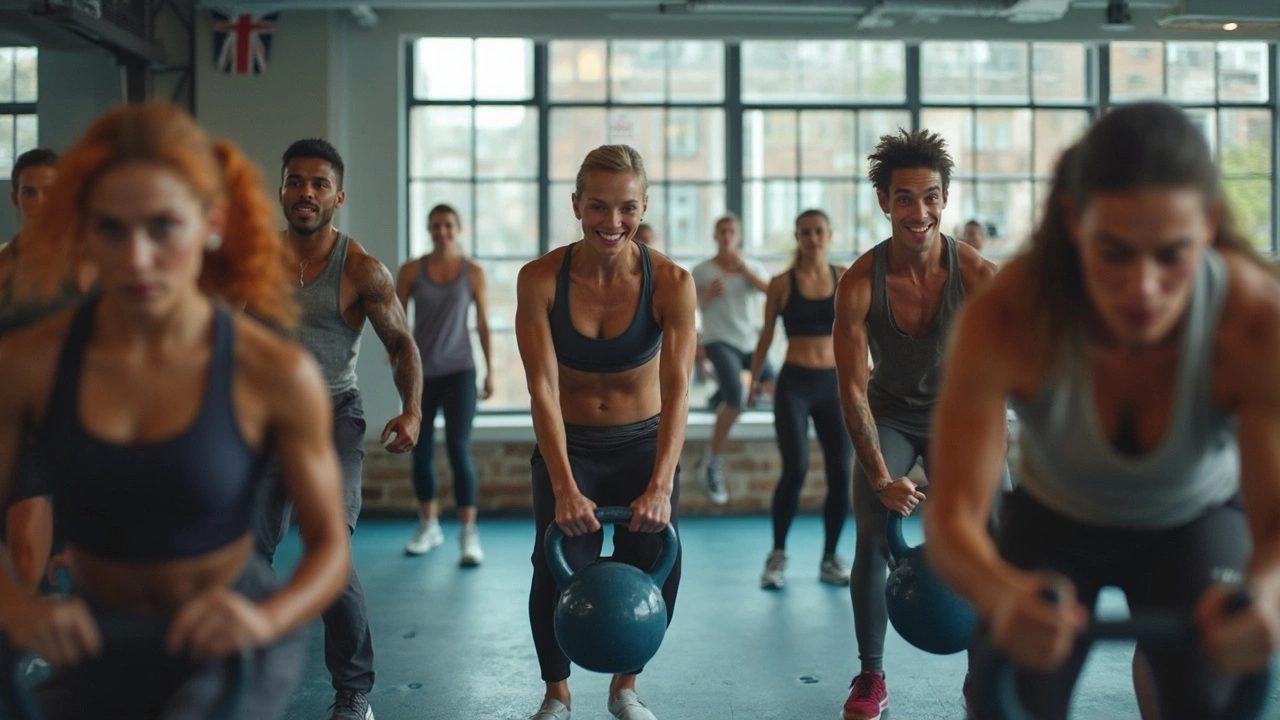
Thirty minutes isn’t just enough for HIIT—it’s all most people need to start seeing real changes. The magic comes from pushing your body, then letting it catch up, over and over. This stops your body from getting used to the same old routine, and that’s why HIIT torches calories in less time than a steady jog.
Here’s what’s wild: research shows your body keeps burning extra calories for hours after you finish a HIIT workout. So even if your session feels short, that afterburn (the official word is EPOC—Excess Post-exercise Oxygen Consumption) keeps the fat-burning party going long after you’ve left the gym or rolled up your yoga mat.
If you’re packing 30 minutes with sprints, jump squats, burpees, or mountain climbers—focusing on real effort—you’re not shortchanging yourself. HIIT wasn’t designed to be an hour-long grind. The short, intense bursts do more for burning fat and building cardio fitness than most longer, mellow routines. And if you’re tight on time (who isn’t?), this matters—a lot.
- What Actually Happens in 30 Minutes of HIIT?
- How Many Calories Can You Burn?
- Why HIIT Beats Traditional Cardio for Many People
- Mistakes That Sabotage HIIT Results
- Tips to Make 30 Minutes Count
What Actually Happens in 30 Minutes of HIIT?
When you dive into a 30-minute HIIT workout, you’re flipping the script on the usual approach to exercise. Instead of keeping the same pace, you blast your muscles and heart with all-out effort, then catch your breath just enough to go again. These cycles of pushing hard and recovering make a huge difference compared to steady-state cardio.
So, what’s actually going on inside your body during those 30 minutes?
- Your heart rate shoots up quickly during the “work” phases, often hitting 80-95% of your max heart rate.
- Your body starts tapping into its stored sugar (glycogen) to fuel your muscles, which means you’re directly burning through your energy reserves.
- Short breaks let your heart and breathing slow down, but not enough to recover totally—keeping your body working overtime to adjust.
- Brain chemicals like endorphins spike, which is why people often feel that “HIIT high” after they finish.
The mix of intense work and active rest doesn’t just leave your muscles burning. It challenges your lungs, heart, and even your metabolism to move faster. This is why HIIT is famous for the “afterburn effect,” where your body keeps burning calories even after you’re done. Scientists call this EPOC, and it can boost your calorie burn for up to 24 hours after a single session.
| Physiological Change | What It Means |
|---|---|
| Heart Rate | Hits 80-95% max (super high!) during sprints |
| Calorie Burn | Approx. 250-450 calories/session (depends on body size & intensity) |
| Afterburn Effect | Up to 15% extra calories burned for hours after |
| Muscle Fiber Activation | Works fast-twitch and slow-twitch fibers (good for strength and endurance) |
| Hormone Release | Spikes endorphins, adrenaline, and growth hormone |
This isn’t just about burning fat. HIIT actually helps you keep (and even grow) muscle while you lose weight, which is a huge win compared to old-school cardio that sometimes eats away at muscle if you overdo it. If you stick to 30 minutes and actually go hard during the work phases, your body will notice a difference—your strength, focus, and energy levels will all get a serious upgrade over time.
How Many Calories Can You Burn?
This is the big question—after sweating through those 30 minutes, how much fat are you actually torching? The answer depends on a couple of things: your weight, how hard you push, and which HIIT moves you're doing. On average, a 155-pound person burns about 250-400 calories in half an hour of true HIIT, while someone closer to 200 pounds might hit closer to 500. If you’re really going all in with sprints or tough intervals, you could even top that range.
What makes HIIT stand out isn’t just the calories you burn while you work out. There’s the bonus afterburn effect, where your body keeps burning calories for hours after the session. Research from the American College of Sports Medicine showed people can burn an extra 100-200 calories over the next 24 hours because their metabolism stays revved up.
Check out this breakdown to see how many calories a 30-minute HIIT session can burn depending on weight and intensity:
| Body Weight (lbs) | Low Intensity | Moderate Intensity | High Intensity |
|---|---|---|---|
| 130 | 180 | 275 | 350+ |
| 155 | 210 | 330 | 400+ |
| 180 | 240 | 375 | 450+ |
| 200 | 265 | 410 | 500+ |
If you want to get a good read on your own calorie burn, wear a heart rate monitor and jot down your stats for a week. Most smartwatches actually get pretty close, and just keeping track can be super motivating.
- If you feel totally wiped after your workout, that's a strong sign you hit the right level of effort and burned a lot of calories.
- If you finish and feel like you barely sweated, it's a cue to step up the intensity next round.
Just remember—what you eat still matters. Cutting calories from food while sticking with regular HIIT is a recipe for real fat loss that you can actually see and feel.

Why HIIT Beats Traditional Cardio for Many People
Ever wonder why some people swear by HIIT instead of slogging it out on the treadmill for an hour? It comes down to getting more results in less time. With HIIT, you alternate between short bursts of all-out effort and quick recovery periods. Traditional cardio—think jogging or cycling at the same pace for 45 minutes—just can’t match the afterburn effect, known as EPOC. That means you keep burning calories even when you’re back at your desk or chilling on the couch.
Check out this quick comparison of calorie burn for a 150-pound person:
| Workout Type | Calories Burned (30 min) |
|---|---|
| HIIT | 270–400 |
| Jogging (moderate) | 210–250 |
| Walking (brisk) | 110–140 |
That’s a big deal if you’re short on time or struggle to fit workouts into your schedule.
Another reason people stick with HIIT? Attention span. It’s way easier to focus during speedy intervals than during a super-long cardio session, so people get bored less often.
HIIT has also been shown in studies to help improve blood sugar, reduce blood pressure, and protect your heart, sometimes even more than traditional cardio. Plus, it helps you hang onto muscle because you’re working harder, not just longer. That’s perfect if you want to lose fat but not end up looking or feeling scrawny.
- Burns more calories per minute
- Keeps your metabolism revved up after you stop
- Can improve heart health faster than steady-state cardio
- Works even if you only have 20–30 minutes
All things considered, HIIT fits into busy routines and gives you more bang for your buck. That’s why so many people ditch traditional steady-state cardio and never look back.
Mistakes That Sabotage HIIT Results
It's wild how easy it is to mess up your HIIT routine—even if you're sweating like crazy. There are a few mistakes that a lot of people make, and these can slow down your progress or keep you from losing weight at all. Let’s break down the main traps you’ll want to dodge.
- Going Too Easy (or Too Hard): HIIT only works if you hit those intense bursts. Just cruising through the motions won’t cut it. At the same time, pushing too hard, too often can burn you out or even get you injured. Finding that sweet spot is key.
- Not Resting Right: People skip the recovery breaks, thinking more work is better. But those short rests are when your body actually gets stronger and ready for the next push. Lose the rest, and you lose results.
- Ignoring Form for Speed: Doing moves fast but with sloppy form isn’t helpful—it actually raises your injury risk, especially with jumps and sprints. Always focus on quality movement.
- No Variety: Repeating the same 4 moves every day? Your body gets used to it, and you stop seeing progress. Mix it up so your muscles don’t get bored.
- Skipping Warm-up and Cool-down: Want to avoid sore muscles or pulling something? Get that heart rate up before you hit full throttle, and ease back down at the end.
Did you know? A study in the Journal of Obesity found that people who did HIIT burned up to 30% more calories in a single session compared to moderate steady-state cardio. But those results tanked when intensity dropped or breaks got skipped.
| Mistake | Better Option |
|---|---|
| Going through the motions slowly | Push hard in every work interval |
| Skipping recovery breaks | Stick to the rest-plan |
| Using poor form | Prioritize correct movement |
| Same moves every time | Switch up exercises weekly |
| No warm-up/cool-down | Spend 5-10 min before/after |
If you’ve hit a plateau or aren’t seeing HIIT results, check for any of these mistakes. It’s usually one or two small tweaks—like picking a tougher round or winding down with a few extra stretches—that make all the difference. The details matter way more than most folks realize.

Tips to Make 30 Minutes Count
If you want your 30-minute HIIT session to pack a punch, a few smart tweaks will help you get the most out of every second. HIIT isn’t about just moving nonstop—it’s about how wisely you mix effort, recovery, and exercise choices. Here’s what really makes a difference:
- Plan Your Moves Before You Start: Wandering around the gym wastes time and ruins momentum. Pick 3-5 moves—like jump squats, push-ups, mountain climbers, and sprints—before you press play on your timer. Stick with compound exercises that work several muscles at once.
- Stick to Work-Rest Ratios That Challenge You: The classic formula is 30 seconds tough work, 30 seconds rest. But if you’re fitter, try 40 seconds on and 20 seconds off, or even 45/15 splits. The key is picking a level where you’re breathing hard and your muscles are burning, but your form isn’t falling apart.
- Don’t Skip the Warm-Up: Give five minutes to dynamic moves like arm circles, butt kicks, and fast high knees. A good warm-up means you’ll bring your A-game to round one and be less likely to pull something halfway through.
- End With a Cooldown: A few minutes of stretching or slow marching brings your heart rate down and helps you recover faster, so you’re ready to come back strong the next day.
- Keep Distractions Away: If you’re working out at home, put your phone on airplane mode. If you’re at the gym, queue up a motivating playlist ahead of time. You want those 30 minutes all-in—no Instagram breaks, no standing around.
And let’s get real: the biggest results don’t come from just showing up, but from showing up focused and pushing your limits. If you treat every HIIT session like it matters, those quick routines add up to serious progress—even more than some longer, half-hearted sweat sessions. Whether you’re after fat loss, building strength, or just finishing your workout without getting bored, these tricks keep you on track. That’s how HIIT helps busy folks get real results—fast.
